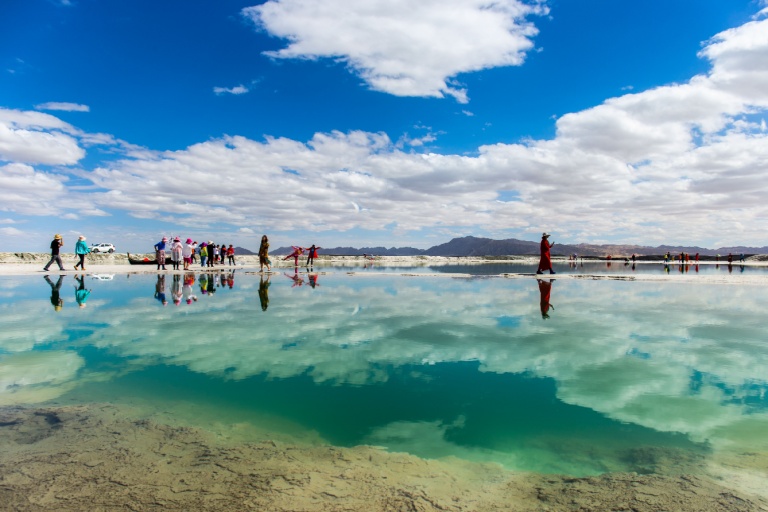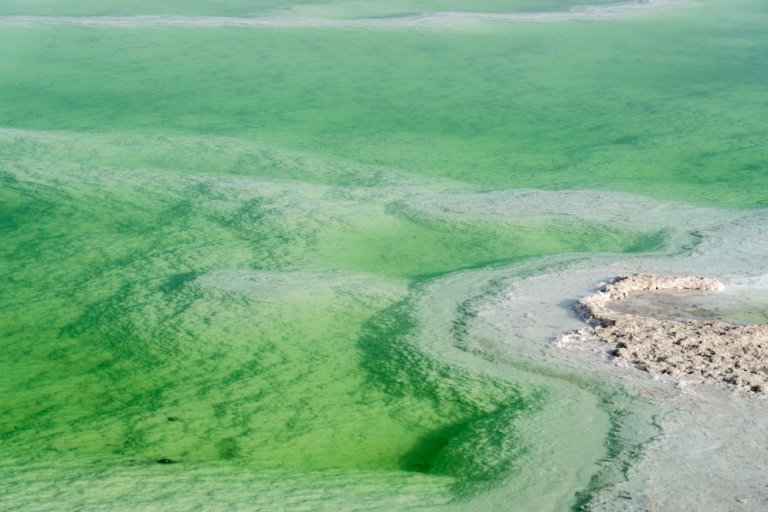China’s Emerald Lake has become the latest sensation among travelers and photographers, captivating thousands suddenly searching for this remote salt pond on the edge of the Qaidam Basin.
In a short YouTube video with more than 1 million views, the creator pans across water so vividly turquoise it appears computer-generated, whispering: “Welcome to Chaerhan Salt Lake in Qinghai, China — locals just call it Emerald Lake.”
Watch the video here:
Yet this viral clip only hints at the wonders that lie beneath the surface, both literally and metaphorically. Sitting 3,148 meters above sea level, this shallow, 36 km² salt lake is a geological marvel, an industrial powerhouse, and an Instagrammer’s dream.
Let’s examine why China’s Emerald Lake enchants the world.
Orientation: Where is China’s Emerald Lake, and how did it form?
China’s Emerald Lake, officially known as Yikechaidamu (Da Qaidam) Lake, is tucked away in Haixi Prefecture, Qinghai Province. It’s a two-hour detour off the G315 “China Route 66,” at coordinates 37.8° N, 95.3° E. The lake sits in an endorheic depression, a remnant of an ancient inland sea. Over millions of years, evaporation concentrated magnesium-sulfate brine, leaving behind a salt-crusted floor. Seasonal meltwater seeps through fissures each year, dissolving the crust and gathering in polygonal pools.
The unique mineral chemistry refracts sunlight into a spectrum of colors, from Tiffany blue to jade green. Satellite images reveal patches of vivid color, some no larger than a football field, nestled beside vast industrial salt pans. This mesmerizing landscape is a paradise for photographers and geologists alike, often compared to Bolivia’s Salar de Uyuni but without the crowds. For the best views, travelers should explore the lake’s southeast rim, where man-made berms create mirror-calm pools perfect for drone footage.
Why is China’s Emerald Lake famous?
The fame of China’s Emerald Lake can be attributed to three main factors. First, it’s an optical illusion: The high salinity (up to 180 g/L) causes particles to flocculate, allowing aquamarine wavelengths to dominate. Visitors often remark that the water seems to glow, especially during golden hour, with no filter required. Second, its economic gravity: As a lobe of the larger Chaerhan Salt Lake, Emerald Lake holds an estimated 60 billion tons of recoverable salts, including potash, which is vital for fertilizer production.
This makes it China’s “strategic salt reserve.” Third, digital virality: The primary viral video juxtaposes Maldives-like visuals with a stark desert backdrop, leading to a 480% spike in Baidu searches for 翡翠湖 (“emerald lake”) the week it aired. Tourism boards quickly capitalized, partnering with content creators and bundling Emerald Lake into eight-day self-drive “Grand Loop” itineraries, which sold out for the 2024 and 2025 summer seasons. The combination of scarcity, surprise, and shareability has elevated this working salt pit to bucket-list status in just two years.

The unique experience of visiting China’s Emerald Lake
Transitioning from its fame, the experience of visiting China’s Emerald Lake is unlike any other. While the lake’s beauty is undeniable, visitors should be aware of the unique challenges and rituals associated with this high-altitude salt wonder. Technically, swimming is possible, but officials strongly advise against it. The magnesium-sulfate brine can cause chemical burns and rapidly dehydrate the skin. Moreover, thin salt crusts sometimes conceal deep brine pockets, posing a risk of injury.
With no lifeguards and minimal facilities — just a hose and a bucket of fresh water at the parking lot — the safest way to enjoy the lake is through the local “foot-soak” ritual: find a firm salt shelf, submerge your ankles for ten minutes, and rinse thoroughly. Drone footage from the viral video shows creators standing — but never swimming — on luminous platforms, reinforcing the unspoken rule. The photo opportunities are spectacular, but nearby freshwater lagoons offer a safer choice for swimming.
What makes China’s Emerald Lake special?
Building on the unique visitor experience, what truly sets China’s Emerald Lake apart is its intricate mosaic of man-made and natural brine pools, each ranging from 20 to 200 meters across. Trace elements determine the color of each pool: copper imparts a teal hue, iron adds a yellow tint, and high boron creates a milky jade appearance. Miners harvest different ponds for specific salts, carving geometric patterns visible even from space.
Environmental scientists study the area as a model for low-energy lithium extraction, which is crucial for China’s 2030 electric vehicle battery targets. Meanwhile, photographers flock to capture the surreal palette, dubbed “God’s overturned paint box” by state broadcaster CGTN. Tour guides now offer sunrise train rides that stop at six color “stations,” transforming industrial tracks into a tourist monorail that moves 700 passengers per day during peak season. Heavy industry, scientific research, and visual poetry converge here, amplifying the impact of each other.
The shallow beauty: How deep is China’s Emerald Lake?
Its surprising shallowness makes the lake’s mesmerizing colors and patterns possible. According to the latest hydrological surveys, the average depth of China’s Emerald Lake is just 2.06 meters, with many salt pans less than half a meter deep. Maximum depths rarely exceed 3 meters, as aggressive evaporation outpaces inflow. This shallow water warms quickly, altering refractive indices and intensifying the lake’s vivid colors — a phenomenon that drone pilots eagerly chase after midday.
The shallow depth also makes the lake economically viable, as pumps only lift brine a few meters to collection vats, significantly reducing energy costs per ton of potash. Thus, the lake’s postcard beauty and strategic value stem from its modest two-meter water column.

From viral short to tourism surge: Marketing lessons from China’s Emerald Lake
The viral YouTube Short that catapulted China’s Emerald Lake into the global spotlight follows a textbook story arc in just 28 seconds. The creator opens with a whisper: “Looks like the Maldives, but we’re 3,000 meters up in China.” A sweeping drone shot reveals emerald polygons stitched into the tawny desert, followed by a call to action: “Save for your China road-trip bucket list.” This formula offers three key lessons for destination marketers: contrast sells — pairing tropical colors with alpine altitude subverts expectations; short-form, mobile-first clips outperform longer vlogs for China travel content; and citing local experts builds trust, as the creator references geologist data on-screen.
Since the video’s release, Qinghai’s tourism bureau has reported a 27 percent year-on-year rise in park ticket scans, and local guesthouses are fully booked for the 2024 and 2025 summer seasons. Plans are underway for an interpretive center and a 5G hotspot, enabling visitors to live stream their experiences without patchy plateau signals. This demonstrates how a single, well-structured short video can transform a region’s tourism economy, offering a blueprint for others to follow.
Conclusion: The enduring allure of China’s Emerald Lake
China’s Emerald Lake proves that scale isn’t everything — a two-meter-deep salt pool can rival the Grand Canyon in online allure. Its shallow, mineral-rich brine bends light into unbelievable greens, while extreme salinity brings beauty and hazard. Strategic storytelling has turned an industrial site into a wanderlust icon. Adventurous self-drivers, drone photographers, and geo-curious scholars alike will find much to discover at this high-altitude jewel. As China’s Emerald Lake continues to inspire awe and curiosity, it stands as a testament to the power of nature, industry, and digital storytelling to transform even the most remote landscapes into global sensations.
Follow us on X, Facebook, or Pinterest

